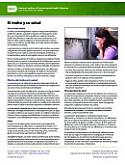Introduction

Molds are microscopic organisms that play an important role in the breakdown of plant and animal matter. Outdoors, molds can be found in shady, damp areas, or places where leaves or other vegetation is decomposing. Indoor molds can grow on virtually any surface, as long as moisture, oxygen, and organic material are present. When molds are disturbed, they release tiny cells called spores into the surrounding air.
How do people get exposed to mold?
People are exposed to molds every day and everywhere, at home, at work, at school, both indoors and out. Molds are generally not harmful to healthy humans.
Inhalation is considered the primary way that people are exposed to mold. Mold spores and fragments can become airborne and get into the air we breathe. People may also be exposed to mold through the skin. Workers should be properly protected with safety equipment when remediating, or cleaning up mold after a disaster. In some cases, people may be exposed to mold through their diet.
What are the most common forms of mold?
According to the Centers for Disease Control and Prevention, the most common indoor molds are:
- Cladosporium
- Penicillium
- Aspergillus
- Alternaria
- Stachybotrys chartarum (also known as black mold)
What are some of the health effects associated with mold exposure?
Symptoms stemming from mold spore exposure may include:
- Nasal and sinus congestion
- Eye irritation
- Blurred vision
- Sore throat
- Chronic cough
- Skin rash
After contact with certain molds, individuals with chronic respiratory disease may have difficulty breathing, and people who are immunocompromised may be at increased risk for lung infection. A study conducted by NIEHS-funded scientists shows that mold exposure during the first year of life may increase the risk of childhood asthma.
What can I do to get rid of mold in my home?
According to the U.S. Department of Housing and Urban Development (HUD), residents can do any of the following to prevent, and or get rid of, mold in their homes:
- Keep your house clean and dry.
- Fix water problems, such as roof leaks, wet basements, and leaking pipes or faucets.
- Make sure your home is well ventilated, and always use ventilation fans in bathrooms and kitchens.
- If possible, keep humidity in your house below 50 percent, by using an air conditioner or dehumidifier.
- Avoid using carpeting in areas of the home that may become wet, such as kitchens, bathrooms, and basements.
- Dry floor mats regularly.
What is NIEHS Doing?
Climate change is a concern for mold spread because conditions inside buildings are influenced by the environment outside them. Building deterioration may result from extreme weather events, increasing the likelihood of mold growth. Under climate change, allergenic mold levels may rise through increased indoor dampness and warmer temperatures.
NIEHS supported the Head-off Environmental Asthma in Louisiana (HEAL) study, following Hurricane Katrina. This storm led to high levels of mold and other allergens, and disrupted health care for children with asthma. HEAL tested an asthma intervention that combined counseling and environmental changes. It successfully decreased the number of symptomatic days in children from 6.5 days to 3.6 days over 12 months. This type of intervention is still used.
After Hurricane Sandy, NIEHS made several resources on mold treatment and cleanup available.
Further Reading
Stories from the Environmental Factor (NIEHS Newsletter)
- Scientific Journeys: Transforming Immunotoxicology Through Discovery (April 2023)
- NIOSH 50th Anniversary Honored by National Toxicology Program (April 2021)
- Keep Indoor Air Clean During Pandemic With Tips Shared in Webinar (December 2020)
Additional Resources
- Captafol Profile: Report on Carcinogens - Captafol was produced and used as a fungicide in the United States until 1987
- Mold - CDC's Mold website provides information on mold and health, an inventory of state indoor air quality programs, advice on assessment, cleanup efforts, and prevention of mold growth, and links to resources
- Mold - Occupational Safety and Health Administration Safety and Health Topics
- Mold - U.S. Environmental Protection Agency
Related Health Topics
This content is available to use on your website.
Please visit NIEHS Syndication to get started.

